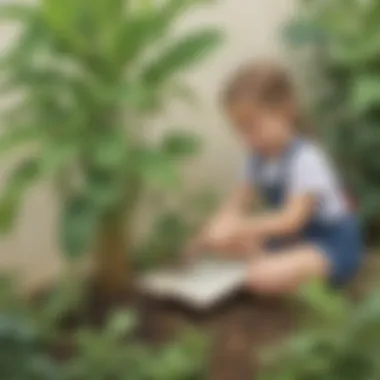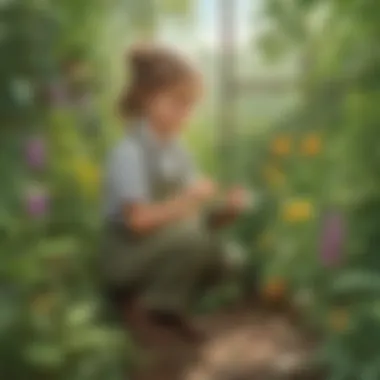Exploring the Fascinating World of Plants with LabLittles: An Educational Adventure for Kindergarten Kids


Science Fun Facts
As we embark on our journey to discover the fascinating world of plants on Lab Littles Portal, let's start by uncovering some interesting trivia and facts about these green wonders. Did you know that plants can communicate with each other through chemical signals released into the air? This unique ability helps them warn other plants of impending threats such as insect attacks. Additionally, some plants have been known to exhibit rapid movement, like the sensitive plant, which folds its leaves in response to touch.
Discover the Wonders of Science
Moving forward, let's delve into exploring various scientific concepts related to plants. Through educational videos and animations, kindergarteners can learn about photosynthesis, the process through which plants convert sunlight into energy. Interactive learning tools on Lab Littles Portal provide a hands-on experience to understand how plants grow and thrive in their environments, fostering a deeper appreciation for the natural world. Real-life applications of science showcase how plants play a crucial role in providing oxygen and food for all living creatures.
Science Quiz Time
Engaging in interactive quizzes tailored for young learners enhances their knowledge retention and critical thinking skills. By presenting multiple choice questions about plants' life cycles, unique adaptations, and environmental significance, children can test their understanding in a fun and stimulating way. Brain teasers and puzzles related to botany challenge their problem-solving abilities and encourage curiosity to explore further. Learning through gamification transforms educational content into an entertaining experience, making the journey of plant exploration captivating and enriching.
Science Experiment Showcase
To complement theoretical knowledge with hands-on learning, Lab Littles Portal offers a range of fun and engaging experiments centered around plants. Step-by-step instructions guide children through activities like observing seed germination, conducting simple plant dissections, and creating miniature terrariums. A detailed materials list ensures easy setup, while safety tips and precautions highlight the importance of responsible scientific exploration. Through these immersive experiments, kindergarteners can cultivate a deeper understanding of plant biology and ecology while honing their laboratory skills.
Introduction to Plants
In the realm of kindergarten education, the introduction to plants holds significant value. It serves as a foundational stepping stone for young minds to comprehend the essence of botany and the wonders of the natural world. Understanding plants not only aids in academic learning but also cultivates a sense of environmental awareness and appreciation for flora. This section will delve into the basic principles of plant life, highlighting key concepts that form the backbone of botanical education for young learners.
Why Plants are Important for Kindergarten Education
Oxygen Production
One of the crucial aspects of plants is their role in oxygen production. Plants, through the process of photosynthesis, convert carbon dioxide into oxygen, which is vital for all living organisms, including humans. The unique ability of plants to generate oxygen not only sustains life on Earth but also demonstrates the interconnectedness of all living beings. This article emphasizes the significance of teaching kindergarten children about oxygen production as a fundamental concept in understanding the essential role of plants in our ecosystem.
Environmental Awareness
Plant studies in kindergarten education also help cultivate environmental awareness among children. By learning about different plant species, their habitats, and how plants contribute to ecological balance, young learners develop a sense of respect for nature. Understanding the significance of plants in maintaining biodiversity and preserving ecosystems instills a lifelong value of environmental stewardship in children.
Nutritional Value
Exploring the nutritional value of plants in kindergarten education introduces children to the concept of healthy eating and the importance of a balanced diet. Plants provide essential nutrients, vitamins, and minerals that promote growth and well-being. By teaching kindergarteners about the nutritional benefits of fruits, vegetables, and other plant-based foods, educators can instill healthy eating habits from an early age, setting a foundation for lifelong wellness.
Plant Parts and Functions
Roots
Roots play a vital role in plant growth and development by anchoring the plant in the soil and absorbing water and nutrients. Understanding the function of roots helps children appreciate the underground world of plants and the significance of strong foundational support for healthy growth.
Stems


Stems serve as the structural support of plants, holding up leaves and flowers while transporting water and nutrients throughout the plant. Exploring the diverse forms and functions of stems in various plant species encourages children to observe and recognize the unique characteristics of each plant they encounter.
Leaves
Leaves are the primary site of photosynthesis in plants, where sunlight is absorbed to produce food in the form of glucose. By studying the shapes, sizes, and arrangements of leaves, kindergarten children can grasp the connection between leaf structure and the plant's ability to harness energy from sunlight.
Flowers
Flowers are the reproductive organs of plants, essential for pollination and seed production. Learning about the diverse colors, scents, and shapes of flowers not only awakens a sense of beauty and wonder in children but also introduces them to the intricate mechanisms of plant reproduction and biodiversity.
The Magic of Photosynthesis
Sunlight Absorption
Sunlight absorption is a critical process in photosynthesis, where plants capture light energy using chlorophyll pigment in their leaves. The ability of plants to absorb sunlight and convert it into chemical energy is key to their survival and growth. By unraveling the magic of sunlight absorption, kindergarteners gain insight into how plants harness energy from their surroundings to fuel their growth.
Food Production
Photosynthesis leads to food production in plants, as they use the energy from sunlight to convert carbon dioxide and water into glucose. This process not only provides plants with the fuel they need to thrive but also produces oxygen as a byproduct, supporting life on Earth. Understanding the food production capacity of plants helps children appreciate the essential role of plants in sustaining ecosystems.
Oxygen Release
Oxygen release during photosynthesis is a crucial byproduct of plant metabolism, contributing to the oxygen-rich atmosphere that sustains living organisms. Plants release oxygen as a result of photosynthetic processes, replenishing the air we breathe and maintaining a balance in the Earth's atmosphere. By grasping the concept of oxygen release, kindergarteners develop a deeper understanding of the reciprocal relationship between plants and the environment.
Types of Plants
Plants play a crucial role in the ecosystem, making it essential for kindergarten children to learn about the various types of plants. Understanding Types of Plants provides young learners with insights into the diversity and importance of plant life. By exploring different plant species, children can develop a deeper appreciation for nature and the environment. This section will cover the key characteristics and benefits of different types of plants, emphasizing the relevance of plant diversity in fostering a love for botany among young learners.
Flowering Plants vs. Non-Flowering Plants
Characteristics of Flowering Plants
Flowering plants are distinguished by their ability to produce flowers, which are essential for pollination and seed formation. The presence of flowers not only adds beauty to the plant but also plays a vital role in the plant's reproductive cycle. Understanding the characteristics of flowering plants introduces children to the concept of pollination and its significance in plant reproduction. Flowering plants are popular choices for botanical study due to their visible and vibrant reproductive structures, making them an engaging topic for exploration in this article.
Characteristics of Non-Flowering Plants
Non-flowering plants, such as ferns and mosses, reproduce through spores rather than flowers. These plants rely on alternative methods for reproduction, showcasing a diverse range of strategies in the plant kingdom. By highlighting the unique features of non-flowering plants, children can appreciate the adaptability and resilience of plant life. Exploring non-flowering plants provides a holistic view of plant reproduction, enriching the understanding of botanical diversity among young learners.
Trees, Shrubs, and Herbaceous Plants
Differentiating Tree Species


Trees are characterized by their woody stems and tall structures, providing essential habitats for various organisms. Identifying different tree species allows children to recognize the diverse forms and functions of trees in the environment. Learning about tree species enhances children's understanding of biodiversity and ecosystem dynamics, emphasizing the importance of trees in sustaining life on Earth.
Identifying Shrubs
Shrubs are smaller woody plants that play critical roles in providing shelter and food for wildlife. Recognizing and identifying shrubs help children appreciate the value of understory vegetation in ecosystems. Understanding shrubs fosters a deeper connection to nature and encourages children to observe the intricate relationships between plants and animals.
Understanding Herbaceous Plants
Herbaceous plants, including grasses and wildflowers, exhibit flexible stems and rapid growth cycles. Exploring herbaceous plants introduces children to the diversity of plant forms and adaptations. Studying herbaceous plants enhances children's comprehension of plant life cycles and underscores the resilience of plants in various habitats.
Carnivorous Plants: Nature's Predators
Pitcher Plants
Pitcher plants are carnivorous species that capture and digest insects for additional nutrients. The unique adaptation of pitcher plants demonstrates the plant's ability to thrive in nutrient-poor environments. Studying pitcher plants showcases the fascinating strategies plants employ to obtain essential nutrients, sparking curiosity and awe in young learners.
Venus Flytrap
The Venus flytrap is a carnivorous plant renowned for its rapid closing trap mechanism, which aids in capturing prey. The distinctive feature of the Venus flytrap intrigues children and introduces them to the concept of plant adaptation for survival. Exploring the Venus flytrap cultivates a sense of wonder and curiosity in children, encouraging them to delve deeper into the intricacies of plant behavior.
Sundew
Sundews are carnivorous plants with sticky tentacles that trap insects, supplementing their nutrient intake. The mechanism of sundews exemplifies the evolutionary specialization of plants to thrive in various environments. Observing sundews in action captivates children's interest and instills an appreciation for the diverse strategies plants adopt to meet their nutritional needs.
Plant Life Cycle
In this informative piece on Lab Littles portal, delving into the specifics of the Plant Life Cycle is paramount. Understanding the cycle of plant growth from seed germination to maturity provides young learners with a foundational knowledge of nature's processes. By dissecting this complex system into digestible parts, children can grasp the intricate stages of a plant's life. Recognizing the cyclical nature of plant life instills inquisitiveness and a sense of wonder about the natural world.
Seed Germination to Plant Growth
Seed Germination stands as a critical stage in the Plant Life Cycle, symbolizing new beginnings and growth potential. The process of seed dispersal plays a pivotal role in this cycle, enabling plants to spread their seeds efficiently in diverse environments. Seed dispersal mechanisms vary among species, showcasing the brilliance of adaptation in nature. Understanding the mechanisms of seed dispersal equips young learners with insights into plant survival strategies and environmental interactions.
The Germination Process unfolds as a fascinating journey from dormancy to vigorous growth. Seeds awaken from their dormant state, germinating under suitable conditions of moisture, warmth, and light. This process highlights the resilience and innate potential harbored within a tiny seed, ready to burgeon into a thriving plant. By observing and documenting the germination process, children develop patience, attentiveness, and appreciation for the miracle of growth.
Maturation Stages mark the culmination of the Plant Life Cycle, showcasing a plant's full development and reproductive readiness. From seed formation to flowering and fruiting, each stage represents a milestone in the plant's lifecycle. Children observing maturation stages learn about the significance of patience, nurturing, and the interconnectedness of life cycles in nature. Witnessing the transformation of a seed into a mature plant fosters respect for the natural world and the processes that sustain life.
Reproduction in Plants
Reproduction in Plants introduces children to the captivating world of pollination, fertilization, and seed formation. Pollination serves as a crucial step in plant reproduction, ensuring the transfer of pollen for fertilization. The intricate mechanisms of pollination, carried out by wind, insects, or animals, demonstrate the precision and elegance of nature's design. Children exploring pollination gain insights into symbiotic relationships and the diversity of pollinators in various ecosystems.
Fertilization merges pollen with the ovule, initiating the formation of seeds within a flower. This process exemplifies the union of male and female reproductive structures, culminating in the creation of new life. Children witnessing the process of fertilization marvel at the intricacy of plant reproduction and the continuity of life through genetic diversity. Understanding fertilization enhances children's comprehension of plant biology and the necessity of reproduction for species survival.


Seed Formation encapsulates the essence of plant reproduction, encapsulating the genetic material necessary for future plant generations. Seeds represent the potential for growth, resilience, and adaptation in changing environments. Exploring seed formation empowers children to recognize the significance of seeds as carriers of life and biodiversity. By comprehending the intricate process of seed formation, young learners develop a deep connection to nature's cycles and the importance of conserving plant diversity for a sustainable future.
Interactive Plant Experiments for Kindergarteners
Interactive plant experiments for kindergarteners play a crucial role in this insightful article centered on exploring plants for kindergarten on the Lab Littles portal. These experiments provide hands-on learning opportunities, allowing young minds to witness botanical concepts in action. By engaging in activities like growing seeds in different environments and creating plant life cycle wheels, children can enhance their understanding of plant biology and ecology. The interactive aspect not only fosters a deep connection to nature but also nurtures their scientific curiosity from a tender age.
Growing Seeds in Different Environments
Water vs. Soil Growth
The comparison between water and soil growth serves as a fundamental element in exploring plant development. Water growth showcases how plants thrive without traditional soil mediums, emphasizing hydroponic cultivation's benefits. This experiment highlights the crucial role of water in plant growth, demonstrating how nutrients are absorbed directly into the roots. Its popularity stems from the ease of observation and the exploration of alternative growth methods. However, the limited support for certain plant species and the challenge of nutrient management are essential considerations in this context.
Sunlight vs. Shade Growth
Understanding the impact of sunlight versus shade on plant growth is essential for appreciating the role of light in photosynthesis. This experiment elucidates how varying light conditions influence plant development, emphasizing the significance of sunlight in energy production. Optimal light exposure ensures healthy growth, making it a preferred choice for studying plant behavior. The distinctive feature lies in contrasting light's effects, offering insights into plants' adaptation mechanisms. Yet, challenges such as light intensity regulation and potential damage from excessive exposure should be acknowledged in this experimental setup.
Temperature Impact
Exploring the effects of temperature on plant growth provides valuable insights into environmental factors' influence on botanical development. This experiment delves into the relationship between temperature fluctuations and plant responses, underscoring the importance of climate control in cultivation. Temperature variations impact metabolic processes and growth rates, making it a pertinent consideration for plant health. The unique aspect of this experiment lies in simulating diverse climate scenarios, enabling children to grasp the significance of temperature moderation. However, challenges like maintaining consistent conditions and interpreting plant reactions accurately are crucial aspects to address.
Creating a Plant Life Cycle Wheel
Seed to Plant Diagram
The seed to plant diagram is a foundational component of understanding plant life cycles, illustrating the sequential stages of germination and growth. By mapping out the journey from seed dispersal to maturation, children gain a visual representation of plant development. This tool simplifies complex botanical processes, aiding in comprehension and retention of knowledge. Its popularity stems from its interactive nature, allowing for hands-on engagement with plant biology. However, ensuring accuracy in depicting growth stages and emphasizing the cyclic nature of plant life are crucial aspects to consider when using this diagram.
Labeling Growth Stages
Labeling growth stages enhances plant life cycle understanding by encouraging active participation in categorizing plant development milestones. This activity promotes sensorial learning, as children annotate different phases like seedling, vegetative, and reproductive stages. By labeling growth stages, young learners reinforce their understanding of plant biology and gain a holistic view of a plant's lifecycle. Its unique feature lies in the personalized learning experience it offers, tailoring knowledge acquisition to individual cognitive styles. Nonetheless, ensuring precise labeling and consistent terminology usage are essential for maximizing educational benefits.
Conclusion
In the final section of this educational journey through plants for kindergarten children on Lab Littles Portal, we consolidate the key learnings and insights gained. The significance of understanding plants at a young age cannot be overstated. Through this article, kindergarten kids are exposed to the essential role that plants play in our ecosystem, from producing oxygen to offering vital nutrients. By exploring plant parts, functions, and the magic of photosynthesis, children begin to grasp the complexities of the natural world around them. Learning about the different types of plants, including carnivorous species, adds a layer of fascination and intrigue to their botanical knowledge. This well-rounded approach not only satisfies curiosity but also lays the foundation for a deeper appreciation of nature.
Nurturing Curiosity and Learning Through Plants
Encouraging Hands-On Exploration:
One of the standout features of this learning experience is the emphasis on hands-on exploration. By engaging in practical activities like planting seeds, observing growth patterns in various environments, and creating a plant life cycle wheel, children immerse themselves in the world of botany. This hands-on approach not only reinforces theoretical concepts but also cultivates a sense of wonder and discovery. The interactive nature of these experiments sparks curiosity and fosters experiential learning, making complex scientific principles easily accessible to young minds.
Inspiring Environmental Stewardship:
Another crucial aspect of this educational endeavor is instilling a sense of environmental stewardship. By educating children about the importance of preserving ecosystems and promoting sustainability, they develop a deep-rooted respect for the environment. Understanding how plants contribute to a healthy planet and the impact of human actions on nature cultivates a consciousness towards responsible ecological practices. By inspiring a sense of duty towards safeguarding our natural resources, children emerge as informed and proactive environmental advocates.
Fostering a Lifelong Love for Botany:
Lastly, cultivating a lifelong love for botany is a key objective of this plant exploration journey. By presenting botanical concepts in a fun and engaging manner, children naturally gravitate towards the beauty and complexity of plants. The exposure to hands-on experiments, interactive learning modules, and real-life applications of botanical knowledge ensures that children develop a lasting affinity for the subject. Nurturing this passion for botany at a young age sows the seeds for future scientists, botanists, or simply nature enthusiasts who appreciate the intricacies and wonders of the plant kingdom.







